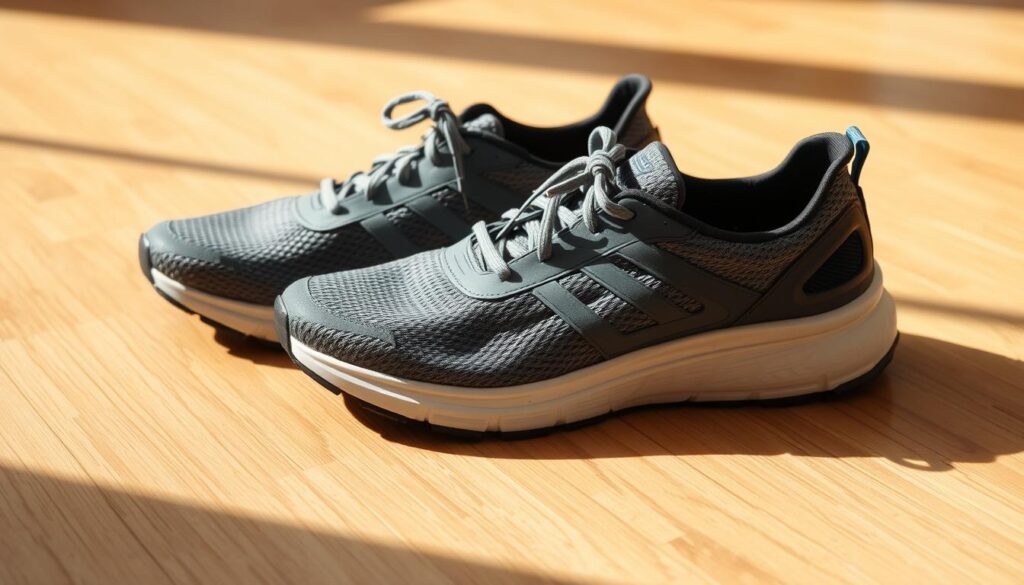What Are The Best Lightweight Running Shoes? As a runner, you know the right gear makes a big difference. Lightweight running shoes are great for both men and women. They offer top performance, support, and cushioning without being too heavy.
Finding the right lightweight running shoes can be tough. We’ve made this guide to help you find the best shoes for your running style. Whether you’re an experienced runner or just starting, we’ll cover the key points.
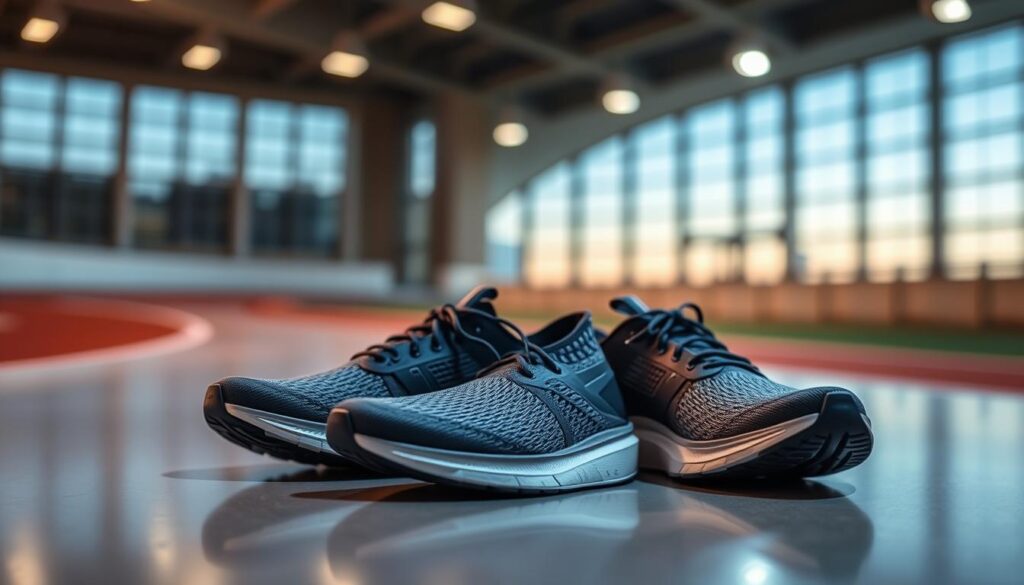
We aim to give you the info you need to choose the best lightweight running shoes. We’ll talk about what to look for, how to pick the right pair, and what brands offer the best options.
Introduction to Lightweight Running Shoes
Lightweight running shoes are fast, flexible, and responsive. They’re perfect for runners who want to get faster and avoid injuries. We’ll help you find the best shoes for men and women.
Key Takeaways
- Lightweight running shoes are designed to provide superior performance, support, and cushioning while minimizing weight.
- Choosing the right pair of lightweight running shoes can improve your running efficiency and reduce your risk of injury.
- There are many different brands and models of lightweight running shoes available, each with their own unique features and benefits.
- The best running shoes for men and women will depend on your individual running style and preferences.
- It’s essential to do your research and try on different shoes before making a purchase to ensure the best fit.
- Lightweight running shoes are perfect for runners who want to improve their performance and reduce their risk of injury.
- Our guide will help you navigate the world of lightweight running shoes and find the perfect pair for your needs.
Understanding Lightweight Running Shoes
Weight is key when it comes to running shoes. It affects how well you perform, how comfortable you feel, and your overall experience. You want a shoe that feels responsive and springy, helping you run faster and more efficiently. To find the right shoe, reading reviews and using a guide is crucial.
A lightweight running shoe offers a comfy and bouncy ride. It’s also gentle on your feet. Reviews can show you which shoes fit best. A good guide helps you choose from various lightweight options.
Choosing a lightweight shoe can elevate your running. It helps you reach your goals faster.
Key Features to Look for in Lightweight Running Shoes
When looking for the best running shoes, it’s key to think about what matters most to you. Running shoe reviews often talk about the importance of cushioning, support, and breathability. These features help make your run comfortable and responsive.
Think about your running style and what you’ll be doing. If you’re a heavy runner, you might need shoes with extra support and cushioning. But if you’re lighter, you might prefer shoes with less cushioning and a minimalist design.
Here are some important features to look for in lightweight running shoes:
- Cushioning: Look for shoes with enough cushioning in the midsole and forefoot. This helps absorb impact and makes your run smooth.
- Support: Choose shoes with supportive features like arch support and stability. These can help prevent injuries.
- Breathability: Pick shoes with breathable materials and mesh panels. They keep your feet cool and dry.
By looking at these features and reading running shoe reviews, you can find the perfect shoes for you. Whether you’re a seasoned runner or just starting, the right shoe can greatly improve your experience.
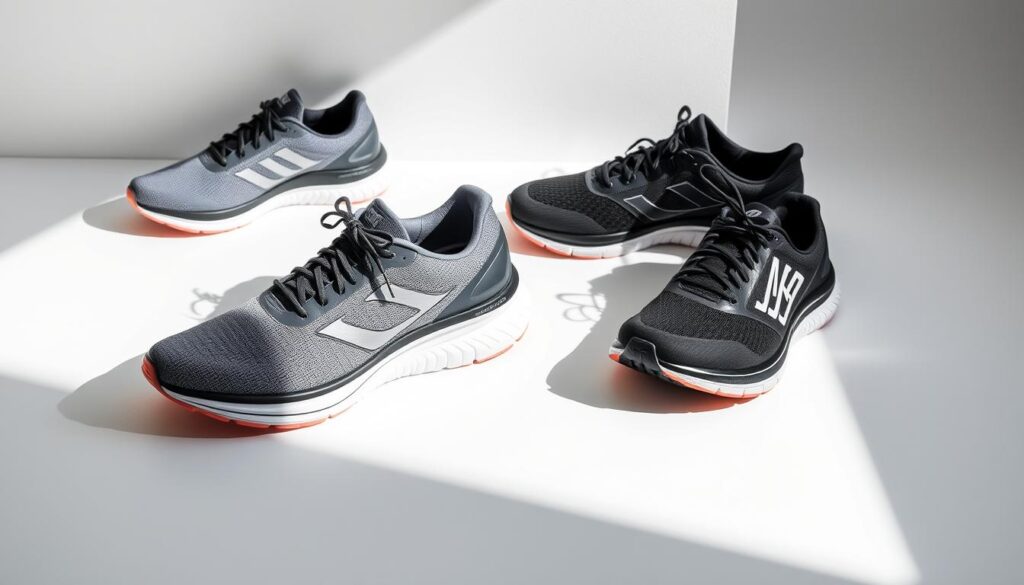
How to Choose the Right Lightweight Running Shoes
Choosing the right lightweight running shoes is key. You need support, cushioning, and traction for better performance. A good guide can help you find the best shoes for your needs.
A running shoe guide is very helpful. It lets you know about different shoes’ performance, comfort, and durability. Lightweight shoes are great for speed and efficiency.

- Assess your running style: Do you pronate, supinate, or have a neutral foot strike?
- Consider your foot type: Do you have flat feet, high arches, or a normal foot shape?
- Evaluate your running goals: Are you training for a marathon, or do you run for fitness and recreation?
Think about these factors to find the right shoes. Try on different pairs and read reviews to find the best fit for you.
Top Brands Making the Best Lightweight Running Shoes
Looking for the best running shoes? Several top brands are known for their innovative designs and quality. Names like Nike, Brooks, and Hoka One One are popular for their lightweight shoes. They’re well-loved for good reasons.
Nike is famous for its responsive midsoles. Brooks offers a supportive ride. Hoka One One is known for max cushioning and comfort. When picking shoes, think about your running style, foot type, and what you like.
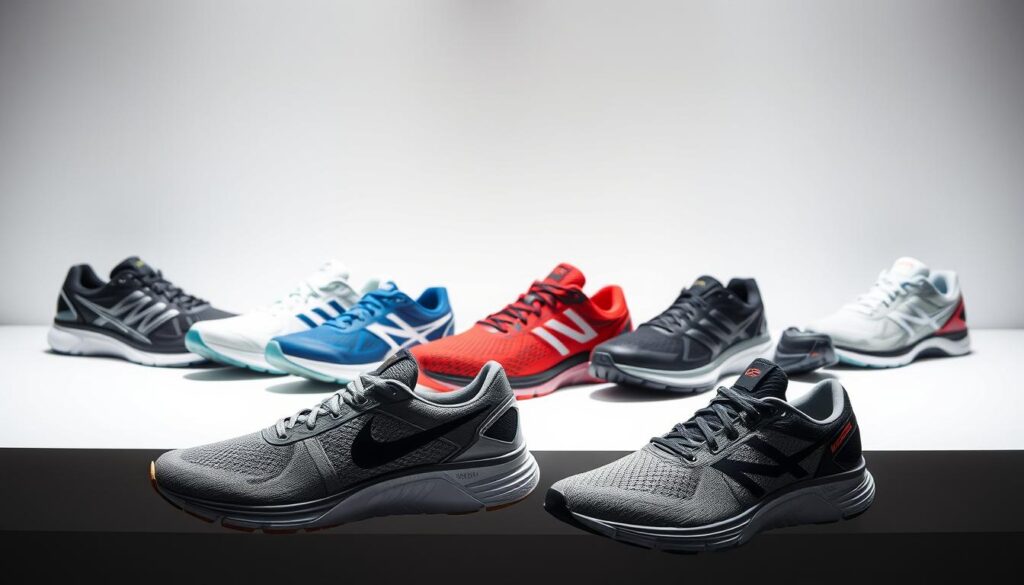
Look for shoes with a breathable upper, responsive midsole, and grippy outsole. Reading reviews can help you find the right pair. Good shoes can improve your performance and running experience.
Here are some key features to look for in the best running shoes:
- Lightweight and breathable upper
- Responsive and cushioned midsole
- Grippy and durable outsole
- Supportive and comfortable fit
By focusing on these features and choosing a reputable brand, you can find the perfect shoes. This will help you take your running to the next level.
Understanding Cushioning vs Weight Trade-offs
When looking for lightweight running shoes, finding the right balance is key. A good running shoe guide helps you see how cushioning and weight trade off. You need a shoe that cushions your feet well but is light enough for a comfy run.
A running shoe review shows how different shoes handle cushioning and weight. Some focus on cushioning, while others aim for lightness. Think about what you need based on your running style and preferences. For instance, heavier runners might prefer more cushioning, while lighter runners might seek a lightweight running shoe.
Here are some things to think about when looking at a shoe’s cushioning and weight:
- Cushioning type: Gel or foam can change how a shoe feels and weighs.
- Weight category: Shoes vary in weight, from very light to more supportive.
- Running style: Your running style affects the shoe you need. Forefoot strikers might prefer less cushioning.
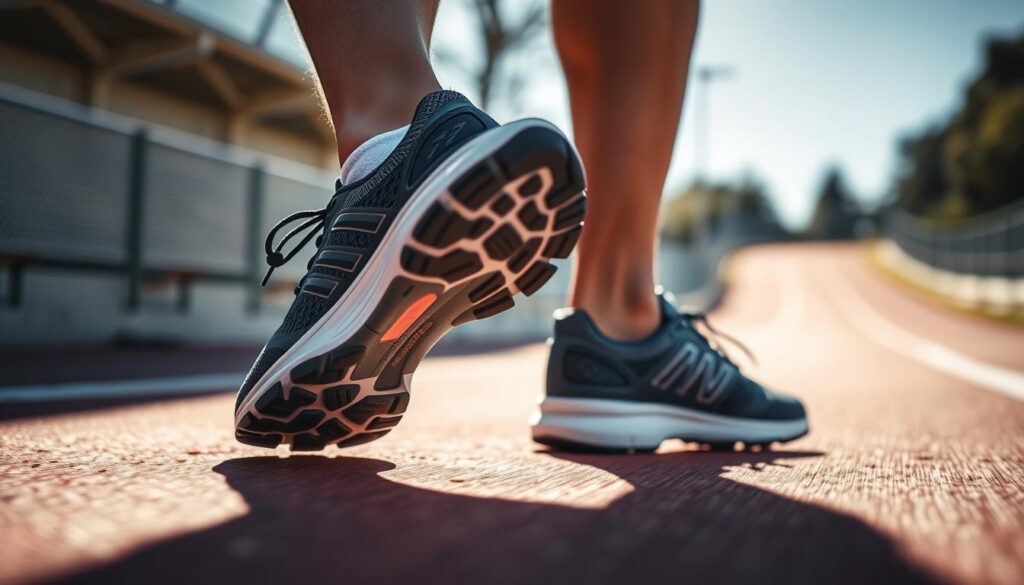
Finding the right balance between cushioning and weight is key for a great run. By considering your needs and reading running shoe reviews, you can find the best lightweight running shoes for you.
Racing Flats vs Training Shoes
Choosing the right shoe for running is key. You need the right tool for training or racing. A good guide can help you find the best shoe, like lightweight ones for better performance.
Reviews often talk about racing flats’ benefits. They are light and feel responsive. But, it’s important to know when to use them and when to choose training shoes. Racing flats are best for short, fast runs. Training shoes offer support and cushioning for longer runs.

There are many running shoes out there, each with its own features. By thinking about what you need, you can find the perfect shoe. Whether you want a light shoe or a supportive one, a good guide can help you decide.
Finding the right shoe depends on your needs and preferences. Knowing the difference between racing flats and training shoes helps you make a better choice. With the right shoe and a good training plan, you’ll reach your running goals and enjoy the benefits of running.
Breaking In Your Lightweight Running Shoes
Getting a new pair of lightweight running shoes is exciting. But, it’s key to break them in right to avoid discomfort and injury. A good running shoe guide will tell you how to slowly introduce them into your routine. Start by wearing them for short walks or jogs around your neighborhood.
To break in your shoes, alternate between your old and new ones for a few days. This helps your feet adjust without too much strain. You can also wear your new shoes for a short run, then a longer run in your old ones. As you get more comfortable, you can run longer and more often.
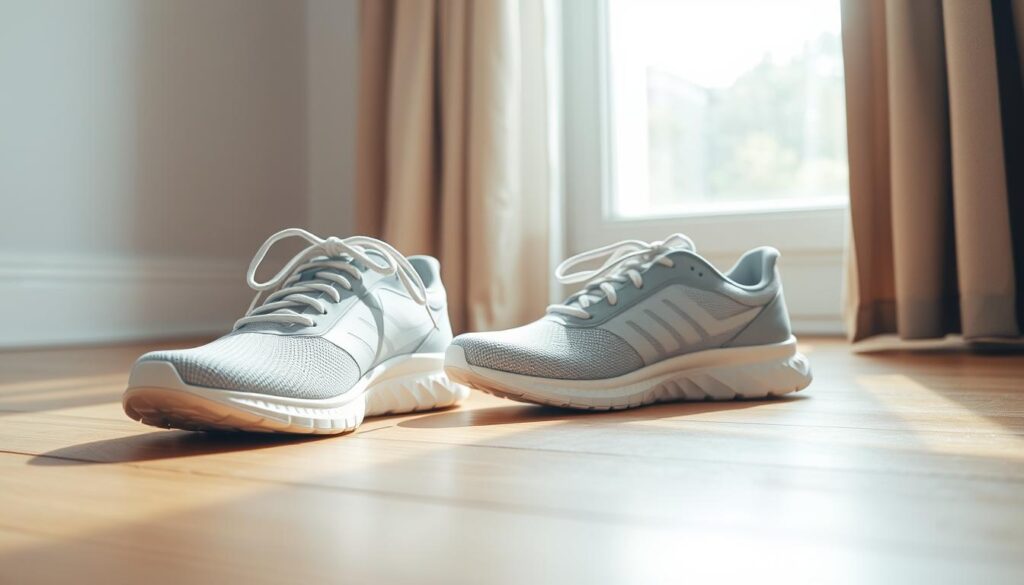
Here are some extra tips for breaking in your new lightweight running shoes:
- Wear the same type of socks you plan to wear during your runs
- Start with short runs and gradually increase the distance
- Pay attention to your body and take rest days as needed
- Consider using orthotics or shoe inserts for extra support
By following these tips and listening to your body, you can smoothly transition to your new lightweight running shoes. Enjoy a comfortable and successful running experience. Always check a running shoe guide and read running shoe reviews to find the best shoes for you.
Maintaining Performance and Durability
Using your lightweight running shoes regularly means you need to keep them in top shape. A well-kept pair can greatly improve your running experience. By following a few easy tips, you can make your shoes last longer and stay comfortable.
Cleaning your shoes gently is key to avoid damage. Use a soft brush to remove dirt and a damp cloth for wiping. For stubborn stains, a mild soap solution works, but test it first. Regular cleaning stops bacteria and odors, keeping your shoes fresh.
Care and Maintenance Tips
- Allow your shoes to air dry after each use
- Avoid exposing your shoes to extreme temperatures
- Use a waterproofing spray to protect the materials
Following these care tips can extend your shoes’ life. It’s also important to watch for wear and tear. For more advice, check out a running shoe guide or read reviews from other runners.
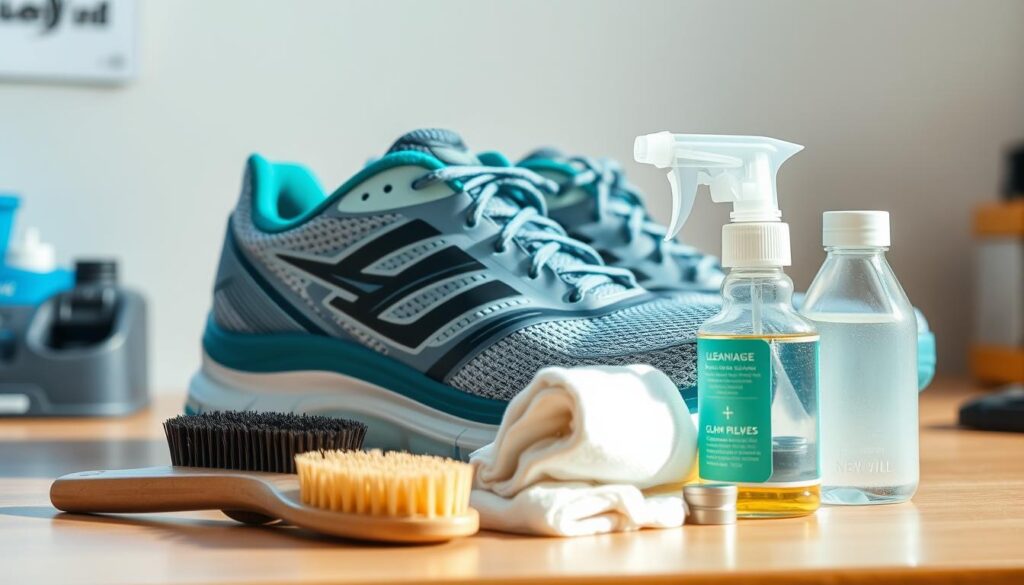
Remember, a great pair of lightweight running shoes can boost your performance. By caring for your shoes, you ensure they support and comfort you as you reach your running goals.
Common Mistakes to Avoid When Switching to Lightweight Shoes
Switching to lightweight running shoes can be tricky. It’s important to avoid mistakes that might cause discomfort or injury. One big mistake is changing your running routine too fast. This can stress your muscles and joints, leading to injuries.
To make the switch smoothly, start by adding lightweight running shoes to your shorter runs. Then, slowly increase the distance and how often you run. It’s also key to pick shoes that support you well and fit right. Look for the best ones by reading running shoe reviews and following a running shoe guide.
Here are some common mistakes to avoid when switching to lightweight running shoes:
- Not gradually introducing the new shoes into your routine
- Not choosing shoes that provide adequate support
- Not getting a proper fit
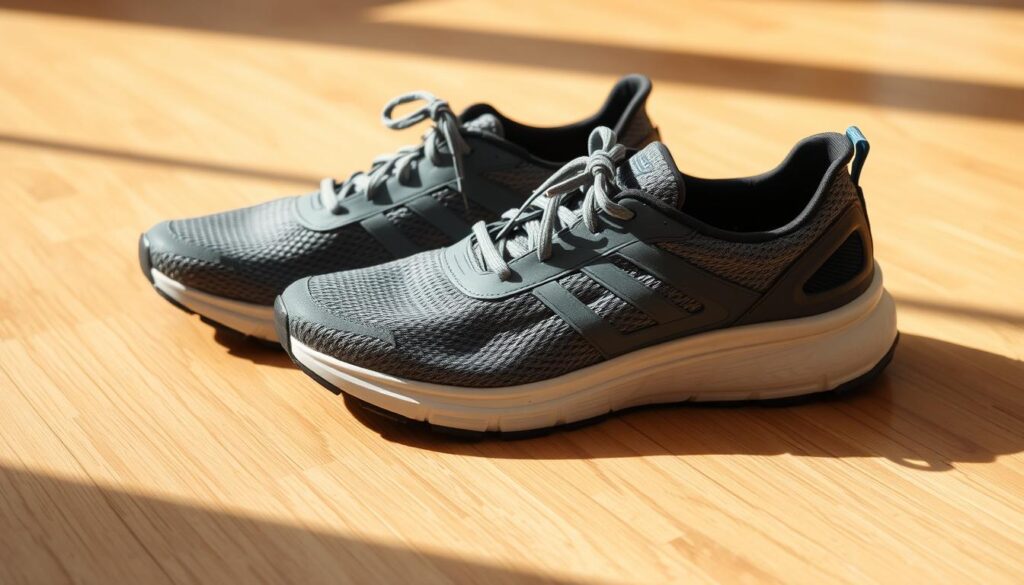
By avoiding these mistakes and using a running shoe guide, you can smoothly transition to lightweight running shoes. This will help improve your running. Always put your comfort and safety first. If you’re unsure, don’t hesitate to ask a running expert for advice.
Price Range and Value Considerations
When looking for lightweight running shoes, price is key. You want a shoe that’s right for you and doesn’t break the bank. With so many choices, it’s easy to get lost. That’s why looking at prices and values is important.
A good guide will show you what different shoes offer. This way, you can see which ones are the best value for your money. Reading reviews and guides helps you make a smart choice.
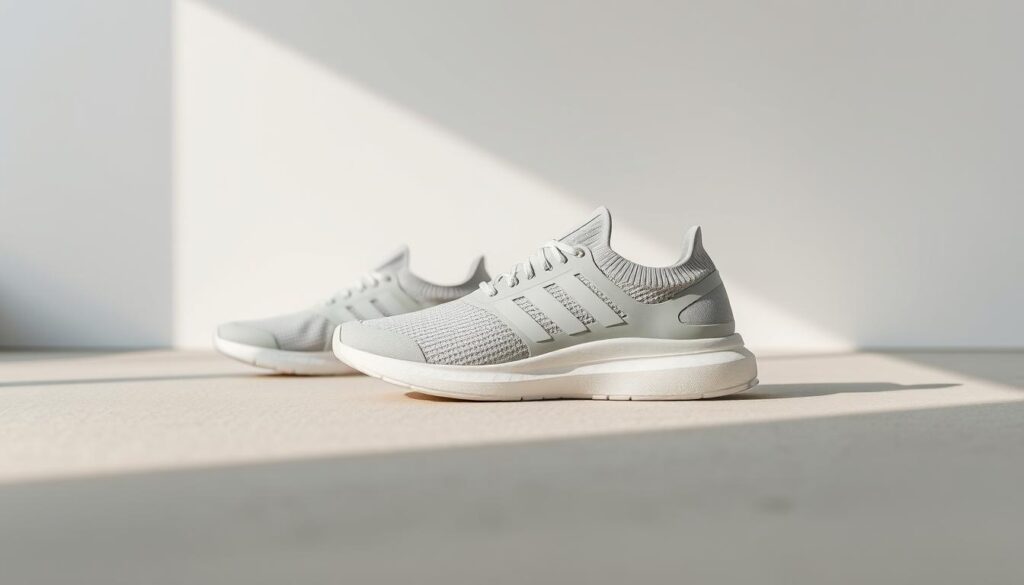
Budget-Friendly Options
If you’re watching your wallet, there are affordable choices. These shoes might not have every feature, but they still offer a good run. Brands like these are great for beginners or those who run casually.
Premium Choices
For those ready to spend more, there are high-end options. These shoes use the latest tech and materials for better performance and comfort. Thinking about the cost per mile can help you decide if a pricey shoe is worth it.
Cost per Mile Analysis
Looking at the cost per mile helps you see the value in different shoes. It lets you compare costs and find the best deal. This method also helps you decide if a more expensive shoe is worth it.
Conclusion: Finding Your Perfect Lightweight Running Partner
Finding the right lightweight running shoes is key to a great running experience. Knowing what to look for and what to consider helps a lot. You’re now ready to start your search.
Don’t forget to try on different shoes, read reviews, and ask for expert advice. This way, you’ll find the perfect shoe for you. With the right shoe, you’ll run faster, feel more comfortable, and be more confident.
FAQ
What are the best lightweight running shoes?
The top lightweight running shoes offer great performance and support. They are perfect for runners who want to move fast and feel light. These shoes are designed to be both responsive and springy.
What makes a running shoe “lightweight”?
Lightweight running shoes are made with materials that are light. This includes the upper, midsole, and outsole. They aim to be comfortable and efficient without being heavy.
What are the benefits of wearing lightweight running shoes?
Wearing lightweight shoes can make you more efficient and responsive. They also help reduce fatigue. Plus, they can prevent injuries by easing the strain on your muscles and joints.
How do I choose the right lightweight running shoes for my needs?
Choose shoes based on your running style, foot type, and goals. Try on different shoes to find the best fit. Look for comfort, cushioning, and how they feel.
What are some of the top brands making the best lightweight running shoes?
Nike, Brooks, and Hoka One One are known for their quality lightweight shoes. They offer innovative designs and superior performance.
How do I balance cushioning and weight when choosing lightweight running shoes?
Finding the right balance between cushioning and weight is key. More cushioning means more weight, but less means less comfort. Choose based on your needs and preferences.
When should I use racing flats vs. training shoes?
Use racing flats for speed and competition. Training shoes are better for daily runs and longer workouts. Choose based on your goals and preferences.
How do I properly break in my new lightweight running shoes?
Breaking in new shoes is crucial to avoid discomfort and injury. Start slow and gradually increase your runs. Pay attention to any discomfort or rubbing.
How can I maintain the performance and durability of my lightweight running shoes?
Clean and care for your shoes properly to keep them in good condition. Replace them when needed and take steps to extend their life. This includes regular cleaning and watching for wear and tear.
What are some common mistakes to avoid when switching to lightweight running shoes?
Avoid sudden changes in your routine and inadequate support. Make a gradual transition and listen to your body. This will help you adjust smoothly.
How do I evaluate the price and value of lightweight running shoes?
Consider the materials, performance, and durability when evaluating shoes. Look for good value, whether it’s budget-friendly or premium. Analyze the cost per mile to ensure you’re getting a good deal.
READ MORE
10 Best Ideas Of Red Tape Shoes Without Laces With Image And Price
